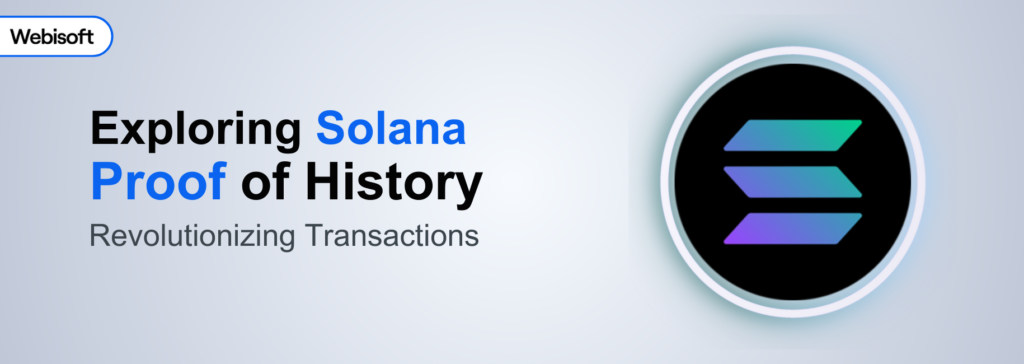Have you ever wondered how blockchain technology could be faster and more efficient? Well, here something that contributed a lot is Solana Proof of History (PoH).
It’s a groundbreaking innovation in the world of blockchain. But what exactly does this technology offer?
Solana’s Proof of History offers lightning-fast transaction speeds. It is capable of easily processing thousands of transactions per second. However, this efficiency leap comes with its challenges, such as maintaining network stability and ensuring widespread adoption in an industry.
Are you getting more interested in Solana Proof of History (PoH)? Today’s guide will explain more details of Solana proof of history. Thus, keep going!
Contents
- 1 What is Proof of History by Solana?
- 2 Proof of History Solana: So, What’s All the Fuss About?
- 2.1 Making Sense of PoH and Its Role in Eventual Consistency
- 2.2 Block Time Revolution: PoH’s Contribution
- 2.3 How Does PoH Work with Proof of Stake?
- 2.4 Trading Speed for Complexity: A Necessary Compromise
- 2.5 Unraveling the Mystery of Time
- 2.6 All Aboard the Train Blockchain
- 2.7 Solana’s Double Play: PoH and PoS
- 3 Core Principles of Solana Proof of History
- 4 How Does it Differ from Proof of Work?
- 5 Pros and Cons of Proof of History
- 6 Use-Cases of Solana’s Proof of History
- 7 Limitations of Proof of History
- 7.1 Complexity in Implementation
- 7.2 Novelty and Unproven Longevity
- 7.3 Dependency on Timekeeping Accuracy
- 7.4 Limited Adaptability to Existing Systems
- 7.5 Higher Resource Demands for Users
- 7.6 Potential Security Risks
- 7.7 Challenges in Consensus Mechanism Integration
- 7.8 Scalability Concerns in High-Demand Scenarios
- 8 Embrace the Power of Solana with Webisoft
- 9 Final Thought
- 10 Frequently Asked Questions
What is Proof of History by Solana?
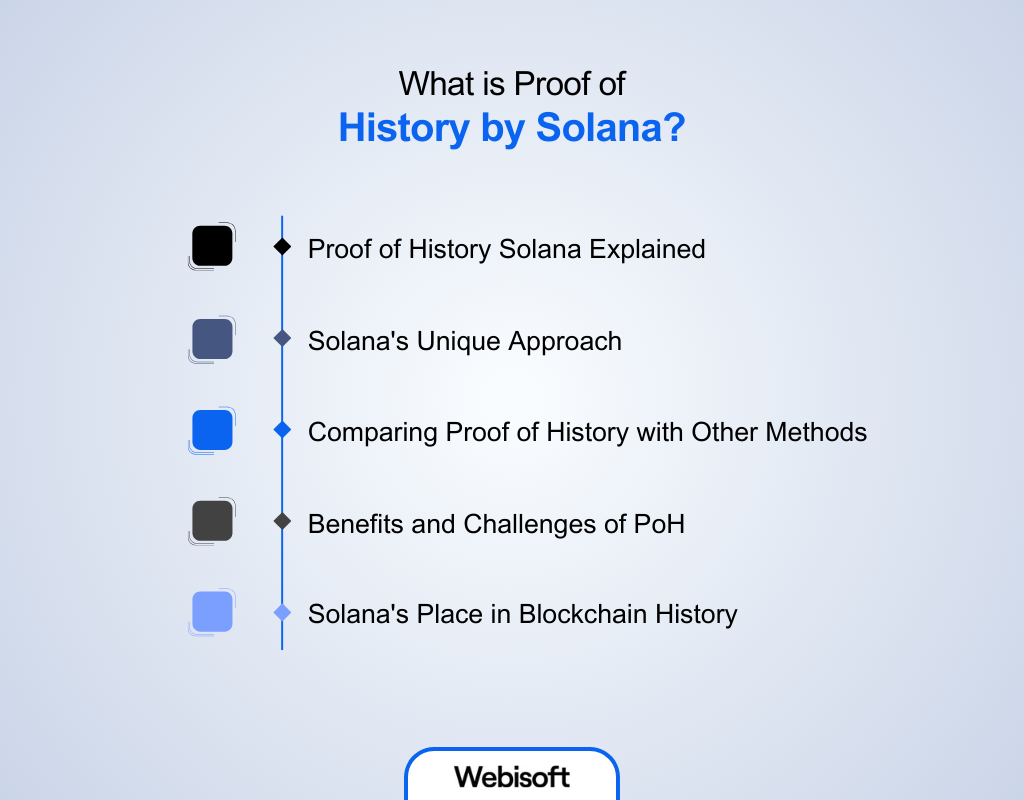
Solana introduces Proof of History (PoH), a novel concept revolutionizing blockchain. PoH differs significantly from traditional methods like Proof of Work or Proof of Stake.
Essentially, it’s a way to record time between transactions, ensuring fast and efficient processing. With Solana, blockchain technology leaps forward, offering unprecedented transaction speeds and efficiency.
Solana Proof of History Explained
Proof of History Solana brings a new dimension to blockchain technology. It works by creating a historical record that proves the existence of data at a specific time.
This method allows the Solana network to process transactions incredibly fast. It is known as Solana TPS (transactions per second). By encoding the passage of time into the ledger itself, Solana ensures each transaction is unique and securely placed in sequence.
Solana’s Unique Approach
Solana’s innovative approach to recording transactions makes it unique in the blockchain space. Unlike Solana Proof of Work, which requires computational effort, or Solana Proof of Stake, which relies on staking, PoH focuses on time sequencing.
This time-based system enables the network to handle thousands of transactions per second. It distinguishes Solana from other blockchain platforms.
Comparing Proof of History with Other Methods
Comparing Proof of History vs Proof of Stake reveals stark differences. Proof of Stake depends on validators and staked tokens for transaction validation. However, PoH uses a verifiable delay function to create a historical record.
This record provides a way to verify the time and order of transactions without relying on external validators.
Benefits and Challenges of PoH
Solana’s PoH offers multiple benefits. Its high TPS rate means faster transactions and improved scalability. However, some more benefits of Solana proof of history are increased transaction speed, improved scalability, energy efficiency, maintaining decentralization etc.
However, challenges exist, like maintaining network stability and adapting to an industry accustomed to traditional methods. Despite these challenges, Solana history represents a significant advancement in blockchain technology.
Solana’s Place in Blockchain History
Solana’s history is marked by its pursuit of efficiency and speed in blockchain technology. By introducing PoH, Solana has positioned itself as a leader in innovative blockchain solutions. Its focus is on solving the scalability issue.
Moreover, it plagues many blockchain networks, highlighting its commitment to advancing the technology.
Proof of History Solana: So, What’s All the Fuss About?
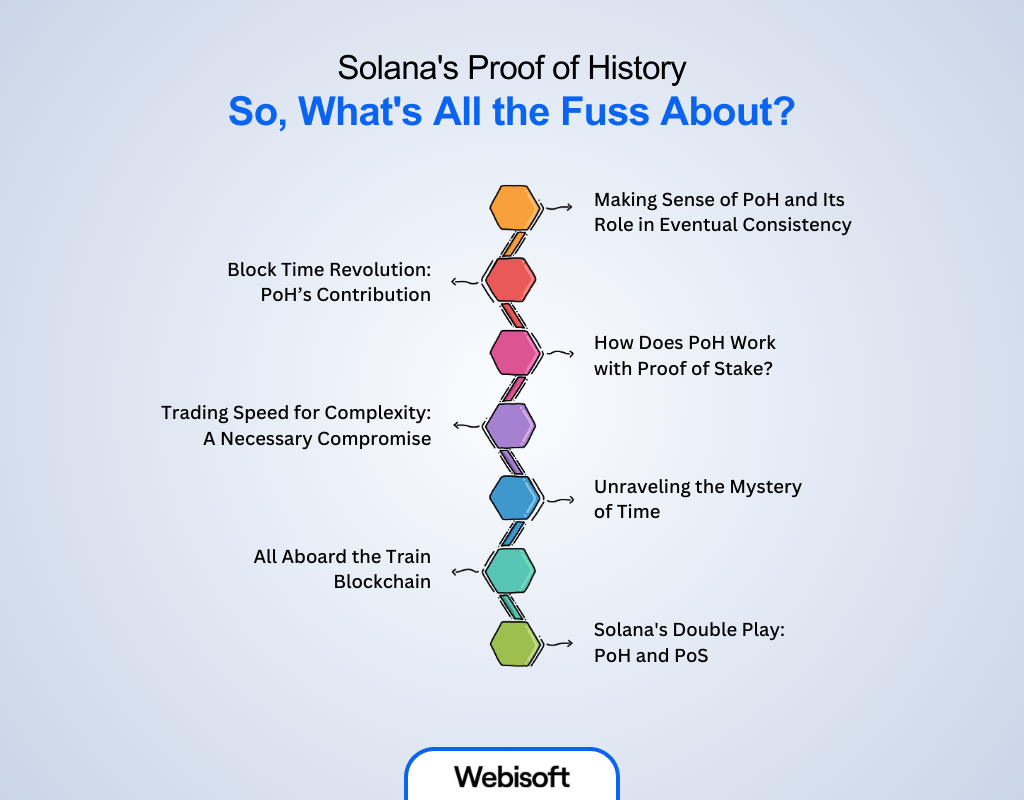
Solana’s blockchain brings something fresh – a feature known as “Proof of History” (PoH). Imagine PoH as a secure timekeeper.
It validates the sequence of each transaction and ensures everything unfolds when it’s supposed to. This unique trait can potentially turbocharge processing times and reduce transaction costs.
Making Sense of PoH and Its Role in Eventual Consistency
In simple terms, PoH functions like a cryptographic clock. It embeds each transaction with a unique timestamp, confirming its position within the timeline of events.
This allows the network to set aside any concerns about confirming the sequence of events. Instead, it focuses on settling the current state of the chain. Doing so ensures that all nodes can devote more energy to processing blocks and validating transactions.
The incorporation of PoH helps Solana establish a robust platform for eventual consistency.
Even when the network faces large partitions or forks, the structure of the system, thanks to PoH, ensures a secure transaction ordering mechanism. This empowers the nodes to continue processing blocks efficiently, maintaining the network’s integrity.
Block Time Revolution: PoH’s Contribution
Comparing PoH with traditional mechanisms like Bitcoin’s Proof of Work (PoW) reveals how revolutionary it is. In Bitcoin’s PoW, block mining and validation enforce ordering.
However, this process is limited—it’s tuned to produce a valid block every ten minutes. Any attempt to increase the validation speed may lead to more block collisions, resulting in diminishing returns. This process also heavily depends on individual validator nodes to enforce ordering.
PoH reimagines this scenario by introducing a cryptographic clock that signs transactions as they appear.
Validator nodes are still tasked with validating the legitimacy of transactions. But PoH assures them that the sequence of transactions has already been verified. This simplifies their job and alleviates the bottleneck associated with PoW.
How Does PoH Work with Proof of Stake?
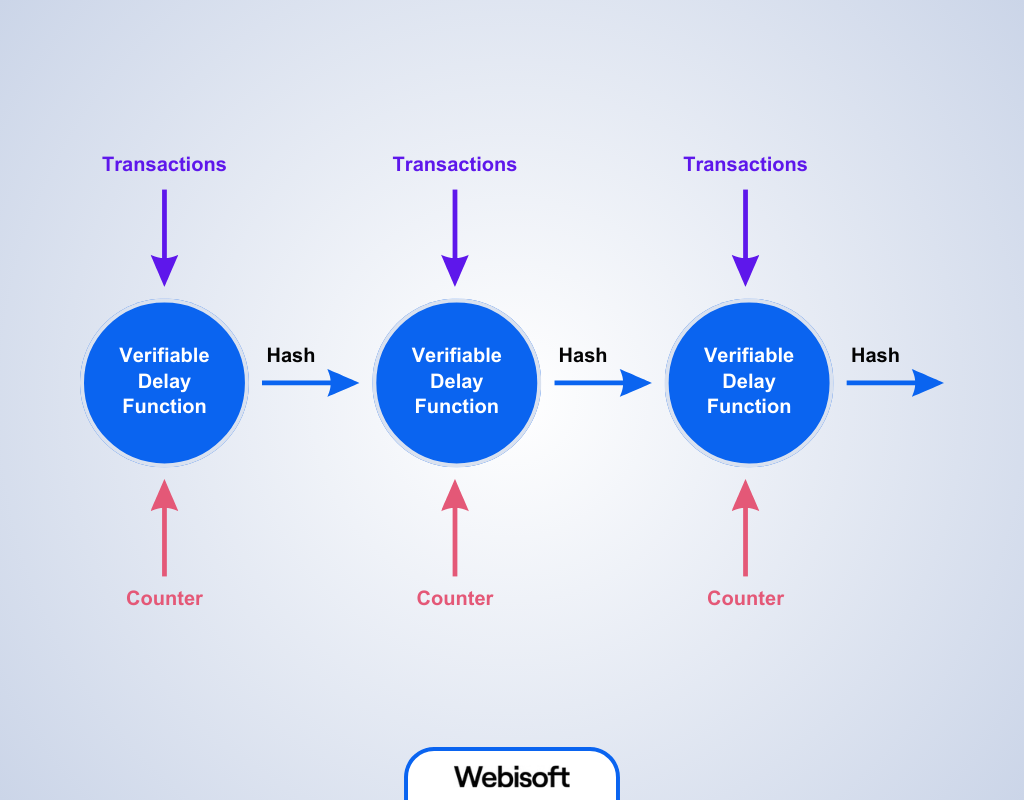
PoH alone isn’t the entire picture. Solana pairs PoH with Proof of Stake (PoS) for a more comprehensive consensus mechanism. Validators in the Solana network work with blocks that are signed by a technique called a “verifiable delay function” (VDF).
The essence of VDF is executing a function. It takes a general input and generates an output. The output can’t be predicted without actually running the function. These functions are chained together—the production of one function becomes the input to the next.
VDF employs a cryptographic hashing function, generating a series of time points that can be cryptographically verified. As these time points are generated, additional information can be added by including it in the hash input. For Solana, this additional information consists of the transactions occurring during each VDF run.
Here is an overview of how VDF timestamps transactions.
Now, let’s break down what Figure represents:
- The PoH generator (or “leader”) receives and timestamps each transaction. These transactions are then distributed to the cluster of validator nodes for consensus.
- Once the transactions are stamped by the PoH generator and distributed, the validators can trust that the sequence of transactions is valid.
- The validated transactions are then returned to the PoH generator, where they’re considered valid.
Solana has a governance system to handle any network failures or attacks. It also has a process for promoting new validators to a leadership position when required.
Trading Speed for Complexity: A Necessary Compromise
The use of PoH allows Solana to improve potential block validation times drastically.
However, this increased speed comes with a trade-off: the higher architectural complexity. This complexity might be a reason behind Solana’s higher rate of outages compared to some other networks.
Unraveling the Mystery of Time
So, let’s start with a pretty straightforward concept, or is it? Yep, we’re talking about time. You’d think it’s simple, right? But scientists are still scratching their heads over whether time is a relative or absolute concept.
You see, Einstein’s theories of general relativity suggest that time is relative, while quantum mechanics argues it’s absolute. Crazy stuff!
Imagine building a decentralized system where hundreds of nodes need to reach a consensus, and timing is crucial. Usually, blockchains tackle this issue by getting timestamps from an external program.
These timestamps help put all transactions in the correct order. But there’s a catch – this approach contradicts the idea of a decentralized system, as it depends on a centralized source for timestamps. Moreover, it creates a ‘code bureaucracy’ slowing things down.
But here comes Yakovenko with an innovative solution. He figured out a way to include these external timestamps on the blockchain. You might wonder, “How does that speed things up?”
If a node knows precisely when a transaction happened, it can validate it much faster. Solana illustrates this using a fun train analogy.
All Aboard the Train Blockchain
Suppose, you have an urgent letter that needs to be on a train leaving New York for Chicago.
The train will stop in Pittsburgh, Philadelphia, and Cleveland before it reaches its final destination. Because the letter is super important, you want to ensure it’s on the right train and reaches every stop on its way to Chicago.
Other blockchains would tackle this by having every train station call each other to confirm the train’s arrival and departure. So, the Pittsburgh station would reach New York to check if the train has left and then call Philadelphia to see if it’s expecting the train.
Then Philadelphia would do the same with Pittsburgh and Cleveland. It’s a whole lot of back-and-forth!
But Solana simplifies this process by including the name of each city (representing the timestamp) where the train stopped on the letter itself.
So now, the attendant at Cleveland can simply check the letter to see where and when the train stopped without having to call other stations. This clever strategy allows the train to reach its destination faster.
In other words, on Solana’s blockchain, one node can validate the whole chain since all necessary information for validation is already included in each transaction. This is what they call Proof-of-History (PoH).
But that’s not all. With Solana’s system, only one node is needed to validate the entire chain. It means validations can be done simultaneously.
Solana’s Double Play: PoH and PoS
However, the PoH method only addresses the timing and speed of consensus. It doesn’t solve the problem of choosing a validator or penalizing naughty validators.
To tackle these issues, Solana utilizes a Proof-of-Stake (PoS) model. This method increases an extra layer of security to the network by requiring validators to have a ‘stake’ in the network. It means they need to hold and commit SOL tokens to be chosen as validators.
This commitment discourages them from validating incorrect transactions as they risk losing their stake.
Core Principles of Solana Proof of History
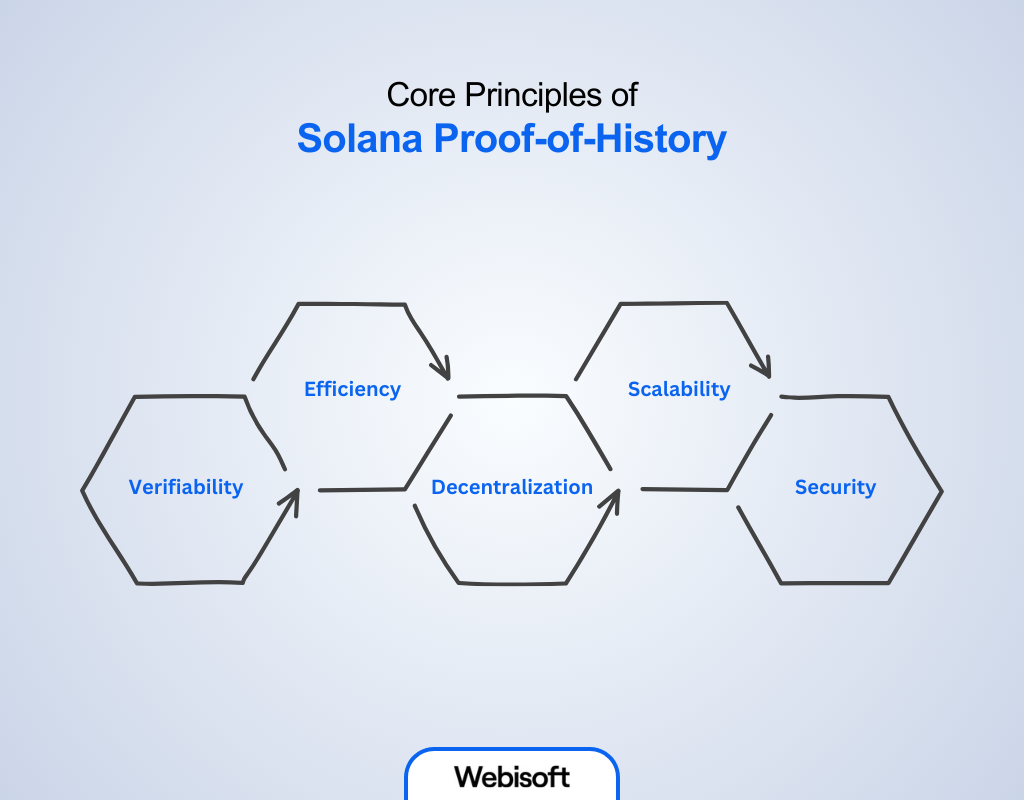
Solana’s Proof-of-History (PoH) is a revolutionary concept in blockchain. It’s reshaping how transactions are processed, offering unique advantages over traditional methods like Proof of Work and Proof of Stake.
Let’s explore the core principles of Solana proof of history.
| Principle | Description |
| Verifiability | Creates a transparent historical record for trust. |
| Efficiency | Rapid transaction processing, high transactions per second. |
| Decentralization | Relies on few nodes, maintaining a distributed blockchain. |
| Scalability | Supports thousands of transactions per second, attractive for complex applications. |
| Security | Ensures fast and secure transactions by sequencing transactions securely. |
Verifiability
At its heart, Solana’s PoH ensures each transaction is verifiable. This system creates a historical record, proving when transactions occurred.
For you, this means higher trust and transparency in transactions. Unlike traditional systems, where verification can be slower, PoH offers a fast, reliable way to confirm transactions.
Efficiency
Efficiency is a hallmark of Solana’s PoH. This approach allows for rapid processing of transactions, significantly raising Solana’s transactions per second (TPS).
Imagine a system with minimal delays, and your transactions happen almost instantly. PoH’s efficiency in Solana makes it stand out in the blockchain space.
Decentralization
While ensuring speed and efficiency, PoH in Solana upholds the principle of decentralization. It only relies on a few powerful nodes for transaction validation, maintaining the distributed nature of the blockchain.
This aspect is crucial as it ensures fairness and security, keeping the network safe from centralized control and manipulation.
Scalability
Solana’s PoH contributes significantly to its scalability. With the ability to take care of thousands of transactions per second, Solana can support a growing number of users and applications.
This scalability makes Solana an attractive platform for developers and users alike. It paves the way for more extensive and complex blockchain applications.
Security
Security in Solana’s PoH is top-notch. By sequencing transactions in a way that’s hard to manipulate, PoH protects the integrity of the blockchain.
Your transactions are fast and secure, giving you security of transactions. Solana’s PoH is a reliable and safe system in a world where digital security is essential.
How Does it Differ from Proof of Work?
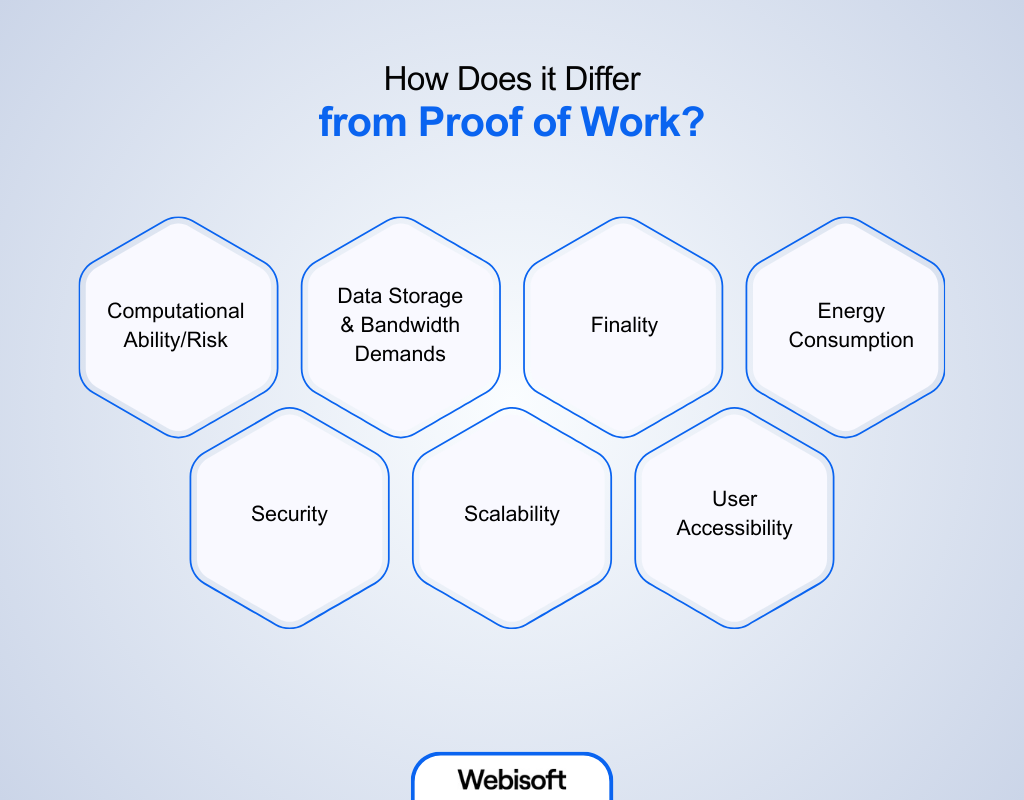
When exploring blockchain technologies like Solana, it’s crucial to understand how Proof of History (PoH) differs from the traditional Proof of Work (PoW). These differences are fundamental to why Solana stands out in the blockchain world.
Let’s break down these significant differences in a simple, easy-to-understand way.
Computational Ability/Risk
Proof of Work demands significant computational power. It often leads to high energy consumption and environmental concerns.
For you, this means PoW can be costly and less eco-friendly. PoH, used in Solana, minimizes these risks. It requires less computational effort, making it a more sustainable and efficient choice.
Data Storage & Bandwidth Demands
PoW systems often struggle with large data storage and bandwidth demands. This can lead to greater blockchain costs and slower transaction times.
In contrast, Solana’s PoH reduces the need for extensive data storage and bandwidth. This efficiency means faster transactions and lower costs for you.
Finality
In PoW, transaction finality can take longer, sometimes leading to uncertainty in transaction completion. PoH in Solana offers quicker finality. This means you can be more confident that your transactions are complete and irreversible in a shorter time.
Energy Consumption
Energy consumption is a significant concern with PoW, as it requires extensive computer processing. Solana’s PoH is much more energy-efficient. This efficiency is good for the environment and also helps keep transaction costs lower for users.
Security
While PoW is known for its high security, it’s often at the cost of speed and energy. Solana’s PoH maintains robust security without compromising on transaction speed or consuming excessive energy. This balance gives you a secure yet efficient blockchain experience.
Scalability
Scalability is a challenge in PoW due to its heavy resource requirements. Solana’s PoH excels in scalability, handling thousands of transactions per second. This scalability ensures that Solana can grow and adapt to increasing user demands.
User Accessibility
PoW often requires specialized hardware, making it less accessible for average users. Solana’s PoH is more user-friendly. It doesn’t need special equipment, making it easier for more people to participate in the Solana network.
Pros and Cons of Proof of History
Solana’s innovative Proof of History (PoH) brings a new perspective to blockchain technology. Like any system, it has its advantages and drawbacks.
Understanding these can help you understand what makes Solana unique and how it compares to other systems like Proof of Work and Stake.
However, let’s check out the pros and cons of proof of history:
Pros of Proof of History
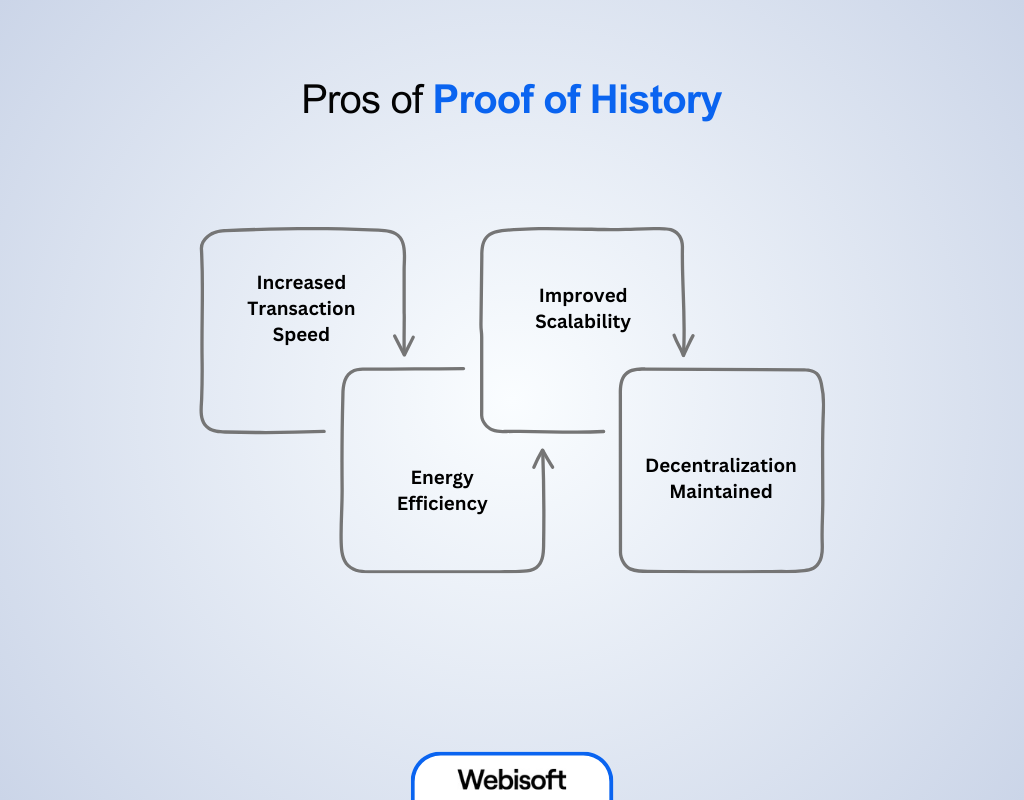
The advantages of proof of history are:
Increased Transaction Speed
Proof of History in Solana leads to faster transaction processing. Known for its high transactions per second (TPS), PoH enables Solana to handle more activity efficiently. This speed is a big plus for users who value quick transactions.
Energy Efficiency
Unlike Proof of Work, Solana’s PoH is more energy-efficient. It doesn’t require the intense computational power that PoW does. This efficiency is good for the environment and reduces operational costs.
Improved Scalability
Scalability is a standout benefit of PoH. Solana can scale up and accommodate more users and transactions without compromising speed or efficiency. This aspect is important for the long-term success of any blockchain platform.
Decentralization Maintained
Despite its unique approach, PoH maintains blockchain’s core feature of decentralization. It ensures that no single entity controls the transaction process, preserving trust and security.
Cons of Proof of History
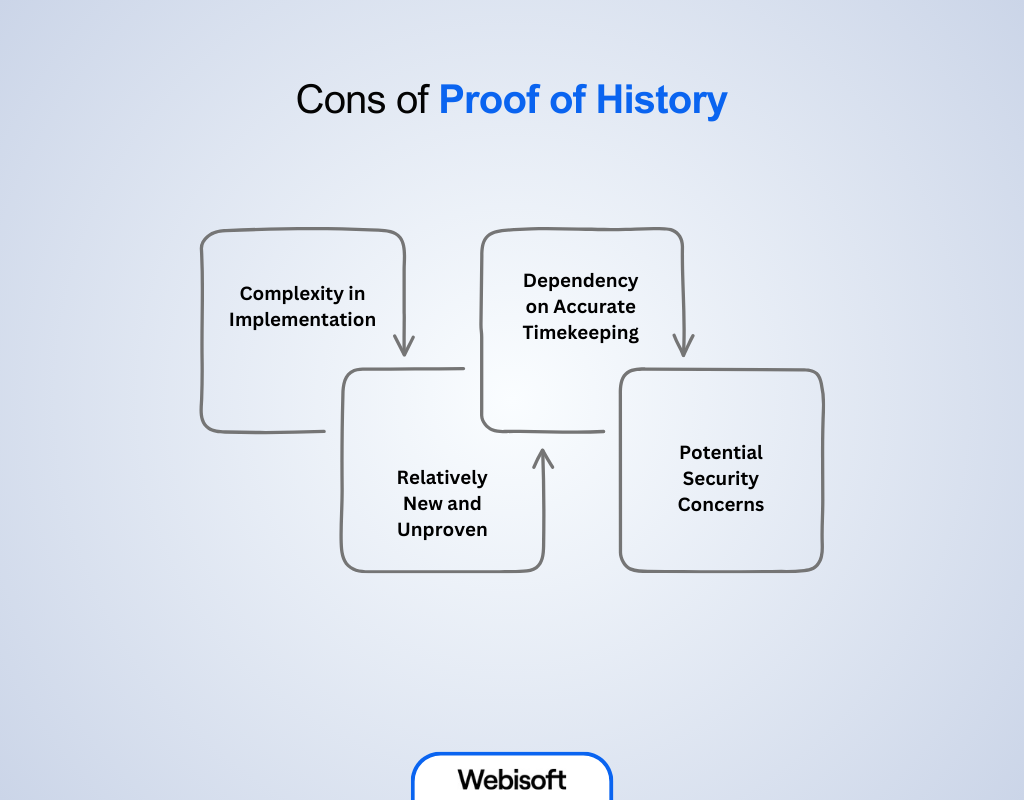
The disadvantages of proof of history are:
Complexity in Implementation
Implementing PoH can be more complex compared to traditional methods. This complexity might challenge new developers or users trying to understand the system.
Relatively New and Unproven
Since PoH is a relatively new concept, it lacks the long-term testing and validation that systems like Proof of Work have. This novelty can raise concerns about unforeseen issues in the future.
Dependency on Accurate Timekeeping
PoH relies heavily on accurate timekeeping to sequence transactions. Any issues with time synchronization could potentially impact the system’s reliability.
Potential Security Concerns
While PoH is designed to be secure, any new system faces potential security challenges. As with any innovative technology, there’s a learning curve in identifying and addressing these issues.
Use-Cases of Solana’s Proof of History
Solana’s Proof of History (PoH) is revolutionizing the blockchain world. Let’s explore how PoH is currently being used and its potential for future applications. This deep dive will help you understand the practicality and versatility of PoH in various sectors.
However, the present and future use cases of proof of history are:
Present Use-Cases of Proof of History
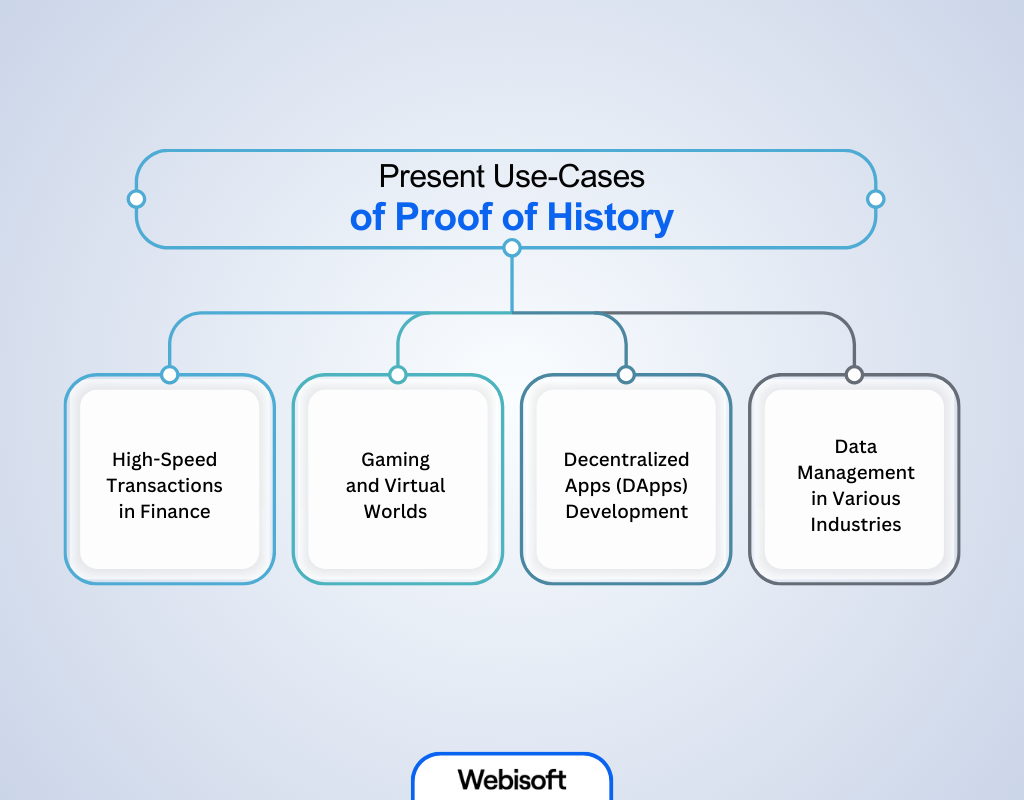
The present use cases of proof of history are:
High-Speed Transactions in Finance
Currently, PoH in Solana is crucial for financial transactions. Its high transaction per second (TPS) rate enables quick and efficient trading. This speed is essential in finance, where even a second’s delay can matter.
Gaming and Virtual Worlds
In gaming, Solana’s PoH is an important factor. It allows for real-time in-game transactions and actions. This means smoother, more immersive experiences for gamers without the lag that can ruin gameplay.
Decentralized Apps (DApps) Development
Developers are using PoH to build DApps on Solana. Its speed and efficiency make Solana a preferred platform for DApps, offering an excellent user experience.
Data Management in Various Industries
From healthcare to the supply chain, PoH enables quick data management. Industries that handle large volumes of data benefit from PoH’s efficient processing, ensuring accuracy and speed.
Future Use-Cases of Proof of History
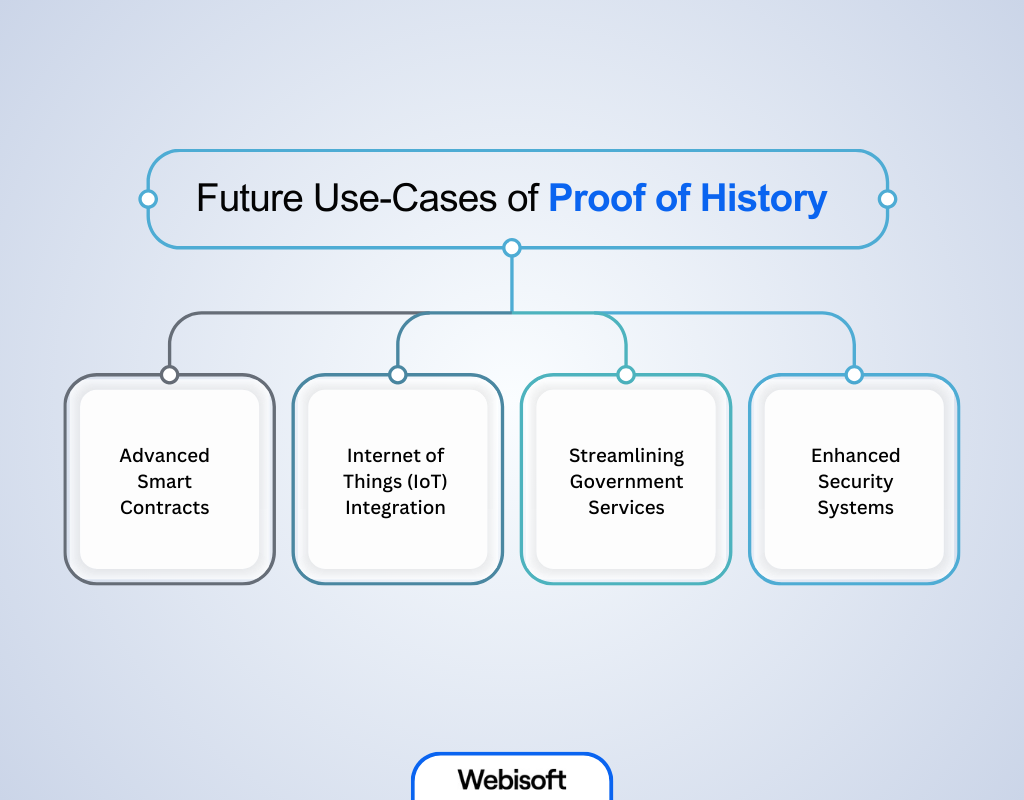
Now, we will explore the future use cases of proof of history:
Advanced Smart Contracts
Looking ahead, PoH could revolutionize smart contract execution. Its speed will enable more complex, real-time contracts, expanding their use in various sectors.
Internet of Things (IoT) Integration
PoH is poised to play a significant role in IoT. Its ability to process data swiftly could lead to more efficient IoT networks where devices communicate and operate efficiently.
Streamlining Government Services
Government sectors could employ PoH for faster, transparent services. Imagine quick processing of legal documents or efficient public service delivery; PoH can make that happen.
Enhanced Security Systems
In the future, PoH could bolster security systems. Its quick verification process can be integrated into security protocols. However, it makes them more robust and reliable.
Limitations of Proof of History
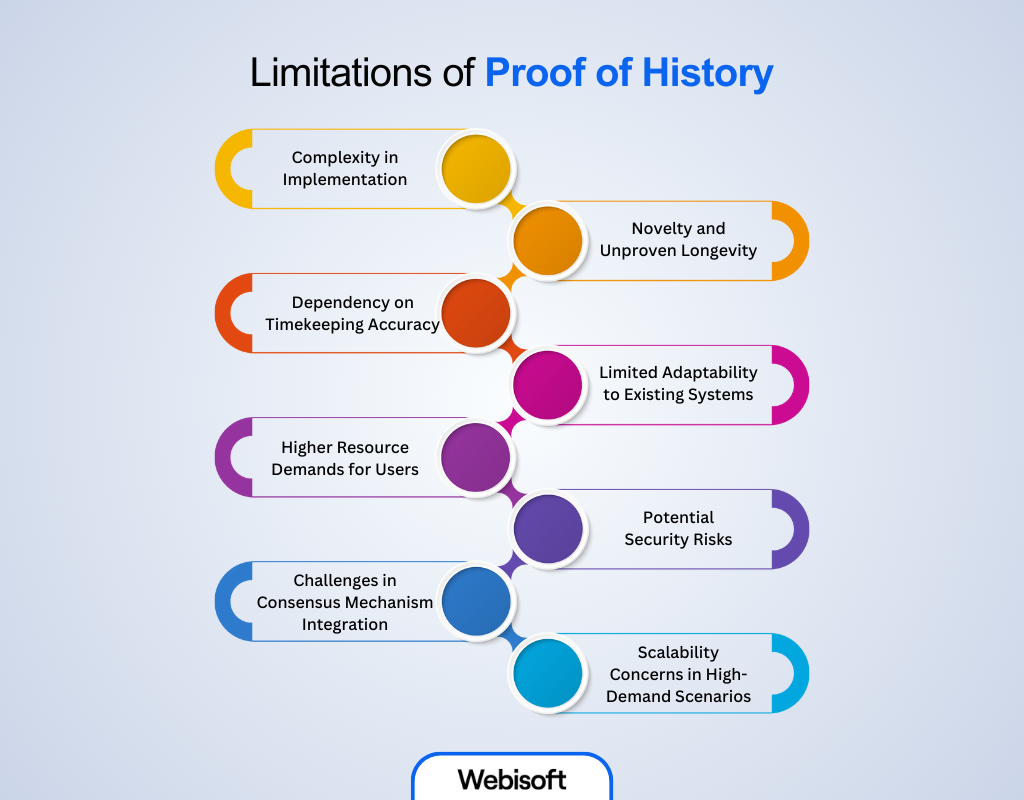
While Solana’s Proof of History (PoH) brings many advancements, it’s essential to recognize its limitations. Understanding the challenges helps assess how PoH fits into the broader blockchain industry and what makes Solana unique.
However, the limitations of proof of history are:
Complexity in Implementation
Implementing PoH, as found in Solana, can be complex. This complexity might pose challenges for developers new to the system. It requires a deep understanding of blockchain to use PoH’s full potential.
Novelty and Unproven Longevity
Since PoH is a relatively new concept, it lacks the long-term testing seen in systems like Proof of Work. For you, this means there might be unforeseen challenges or scalability issues that only time will reveal.
Dependency on Timekeeping Accuracy
The effectiveness of PoH heavily relies on precise timekeeping. Any discrepancies in time can affect the sequencing of transactions, potentially leading to errors or security vulnerabilities.
Limited Adaptability to Existing Systems
Integrating PoH with existing blockchain systems can be difficult. Its unique approach might not align well with traditional systems, potentially limiting its adaptability and integration.
Higher Resource Demands for Users
Running a node on a PoH-based system like Solana may require more user resources. This could include better hardware or more bandwidth, potentially limiting accessibility for some users.
Potential Security Risks
As with any new technology, PoH faces potential security risks. The unique nature of PoH might present security challenges that are different from those in Proof of Work or Proof of Stake systems.
Challenges in Consensus Mechanism Integration
Integrating PoH with other consensus mechanisms can be challenging. Ensuring PoH works efficiently with mechanisms like Proof of Stake requires careful design and implementation.
Scalability Concerns in High-Demand Scenarios
While PoH improves transaction speed, scalability in high-demand scenarios can be a concern. Ensuring that PoH can handle an increasing load is crucial as the network grows.
Embrace the Power of Solana with Webisoft
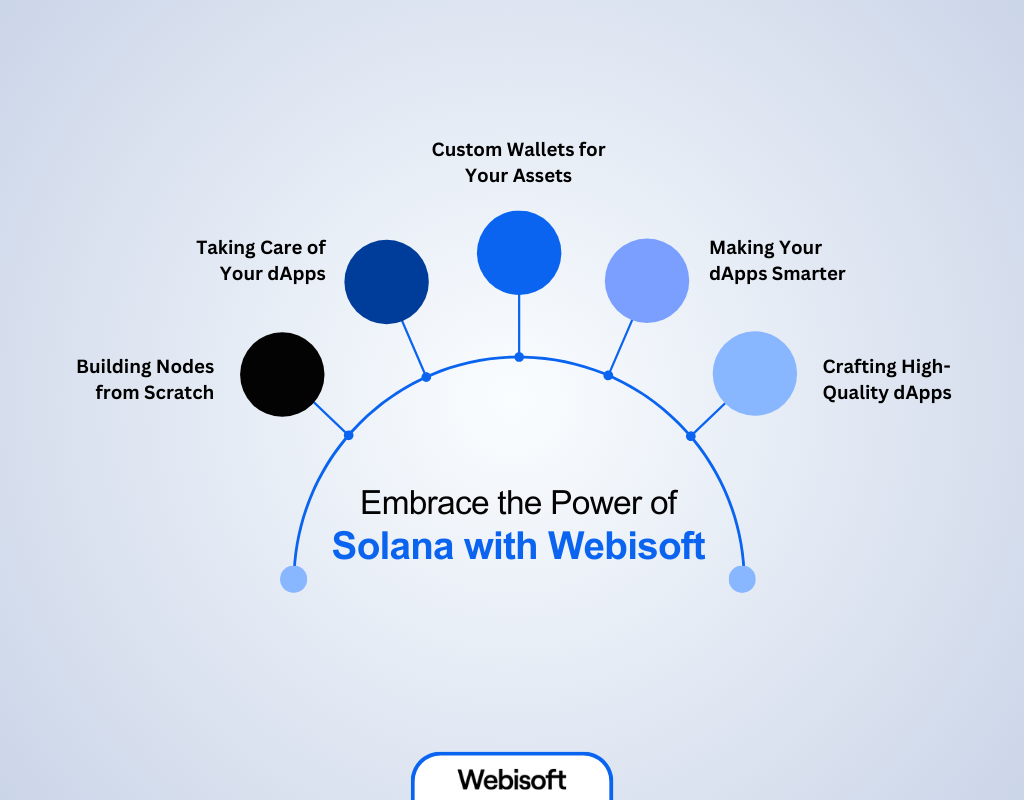
Ready to harness the might of the Solana blockchain for your business? At Webisoft, we’re all set to help. Here’s a sneak peek of what we offer:
Building Nodes from Scratch
Our first stop on this journey is node creation. Our blockchain wizards can create sturdy nodes for both public and private blockchain networks.
The best part? We’ll align them perfectly with the existing consensus protocol.
Taking Care of Your dApps
Is a decentralized app (dApp) running on Solana that needs some love? We’ve got your back! We deliver top-of-the-line support and maintenance.
Whether you already have a dApp or created one for you, we’re dedicated to being there for you, no matter what.
Custom Wallets for Your Assets
Looking for a safe spot for your digital currencies and assets? Our adept blockchain builders can put together a custom-made Solana wallet for you.
Not only will you have a secure place for your digital currencies and assets, but you’ll also have the power to check your balance. Also, you can monitor all of your transactions with ease.
Making Your dApps Smarter
Keen to get your dApps working more intelligently? We’re here to help with our Smart Contract development offerings. Solana’s public blockchain development network uses the Rust programming language for Smart Contracts.
We can assist with everything— from drafting and implementing these Smart Contracts to auditing them and ensuring they perform at their best.
Crafting High-Quality dApps
Finally, we’ve got a crack team of blockchain experts who excel at crafting top-tier, enterprise-grade dApps using the Solana platform. Partnering with us means you can hit the market quicker and see a better return on your investment.
So there you have it—that’s a quick tour of our Solana blockchain services at Webisoft. We’re ready and eager to help you tap into the immense potential of this robust platform!
Final Thought
In conclusion, Solana’s open-source platform comes with its revolutionary Proof of History. Solana proof of history has transformed the blockchain industry. Gone are the days of slow transaction processing, as seen in systems like Bitcoin.
Solana’s approach timestamps each transaction individually, creating a more efficient, traceable, and secure system. If Solana’s innovative blockchain technology inspires you to develop decentralized applications, Webisoft is your go-to partner.
Let us help bring your project vision to life with our expertise in blockchain development. Reach out to Webisoft for your blockchain development needs and start shaping the future of decentralized applications.
Frequently Asked Questions
Is Solana’s Proof of History different from Bitcoin’s system?
Unlike Bitcoin’s Proof of Work, Solana’s method focuses on time sequencing for efficiency, not on solving complex mathematical problems.
Can Proof of History enhance security on Solana?
Yes, it adds an extra security layer by accurately and sequentially recording each transaction.
Why does Webisoft recommend Solana’s Proof of History?
Webisoft believes it represents a significant advancement in blockchain technology, offering speed and efficiency benefits.
Is Solana’s Proof of History environmentally friendly?
Yes, it consumes less energy than traditional Proof of Work systems, making it a more sustainable choice.
How does Proof of History impact transaction speed?
It drastically reduces processing time, allowing for thousands of transactions per second.
